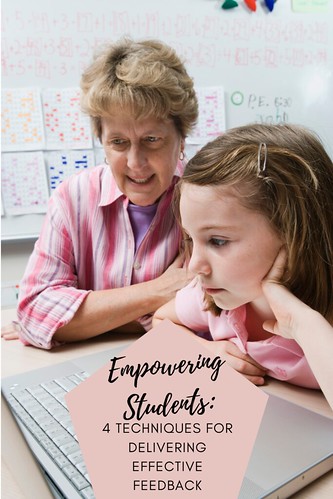Empowering Students: 4 Techniques for Delivering Effective Feedback
Feedback is essential to learning, as it helps students understand their strengths and weaknesses, identify areas for improvement, and track their progress. However, the process can be stressful for both teachers and students.

Educators always worry about how to effectively deliver feedback without demoralizing the students. On the students’ part, there may be anxiety due to feedback or the disappointment of not meeting expectations.
Teachers need to approach feedback with empathy, recognizing each student as a unique individual with unique strengths, weaknesses, and learning styles. The goal should be to provide positive reinforcement and constructive criticism and make students feel comfortable throughout the process.
The Value of Feedback in Learning
As mentioned earlier, feedback provides insights into students' performances, revealing where they excel and need improvement. However, feedback goes beyond that, as it also helps foster a growth mindset, which makes students see challenges as learning opportunities rather than setbacks.
Feedback helps students progress by providing actionable steps to work on their weaknesses. This consequently improves their morale as they can see tangible ways to move forward.
Educators should always encourage their charges to reflect on their feedback. When students reflect on the feedback they receive, they can identify areas for further exploration or practice. And doing this empowers them to take ownership of their learning journey.

Below are some of the key characteristics of good feedback:
Timeliness: Closely following the completion of a task or assignment.
Specificity: Help students understand what they did well, what needs improvement, and how to improve next time.
Individualization: No two students are exactly alike, and recognizing and respecting this is crucial to effective feedback.
Constructiveness: Guide improvement rather than simply pointing out shortcomings.

4 Ways Educators Can Achieve Effective Feedback

Proper Assessment
Assessment is the foundation of effective feedback, allowing teachers to evaluate their students and identify their strengths and weaknesses. Without proper assessment, educators may be misinformed about their students’ needs.
Several methods and practices are available for educators to evaluate their students. They include formative assessment, summative assessment, peer and self-assessment, and alternative assessment like projects, debates, and tasks that reflect real-world applications of knowledge and skills. It's up to the teacher to choose methods relevant to their teaching context and the specific learning objectives they aim to achieve.
Assessments must be inclusive. There should be accommodations for English Language Learners (ELLs), students with disabilities, anxiety, limited prior educational opportunities, and so on.
Educators get concrete evidence of a student’s ability when feedback is based on accurate assessments. Students are also more likely to trust the validity of their feedback and take it seriously.
Center the Feedback on Skills and Processes, Not Individuals
The words of clinical psychologist Dr. Susan Heitler, “Criticism complains while feedback explains,” is something educators should take to heart. There's a world of difference between criticism and feedback, and teachers must be careful not to unintentionally switch to criticizing instead of providing constructive feedback.
Intent is the bedrock of constructive feedback. The intention should be to provide guidance and support to help students become better.
For example, a student, Jack, needs help organizing his ideas and essay. Criticizing Jack’s writing could damage his confidence and disengage him from learning. Jack may even start to see himself as a bad writer.
Instead, the teacher should schedule a one-on-one meeting with Jack and start by highlighting the positive aspects of his writing, which could be his creativity or the originality of his ideas. Then, the teacher gently points out areas where Jack’s essay could be strengthened and offers specific suggestions to help him improve his writing while maintaining a supportive and encouraging tone.
This process allows Jack to see the feedback as an opportunity for growth, and not see his current skills as a reflection of his worth as a writer or person.
Avoid Empty Praise
While praise can be motivating and uplifting when genuine and meaningful, teachers should avoid empty praise when delivering feedback. Empty praise is compliments that lack substance or specific information. Praise should be reserved for when students demonstrate desired behaviors or achieve learning goals. In cases where neither has been completed, teachers should use positive feedback, which entails specific and constructive comments about what the student has done well.
For instance, in the scenario mentioned earlier, the teacher effectively utilized positive reinforcement by acknowledging Jack's creativity before offering guidance for improvement. Once Jack demonstrates considerable improvement in his essay, the teacher can then offer genuine praise, reinforcing his progress.
Future-Oriented Approach
Feedback should always take a future-oriented approach. While feedback provides information about past performance, one of its primary goals is to bring about improvement and growth in the future.
Educators should always strive to use an optimistic tone when delivering feedback to students. An optimistic tone suggests that improvement is possible, instills confidence in the students, motivates them to strive for success, and views challenges as opportunities.

-

- Log in to post comments



















